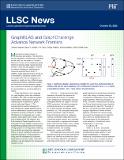| dc.contributor.author | Kepner, Jeremy | |
| dc.contributor.author | Bader, David A. | |
| dc.contributor.author | Davis, Tim | |
| dc.contributor.author | Pearce, Roger | |
| dc.contributor.author | Wolf, Michael M. | |
| dc.date.accessioned | 2022-11-09T02:18:45Z | |
| dc.date.available | 2022-11-09T02:18:45Z | |
| dc.date.issued | 2022-11-09 | |
| dc.identifier.uri | https://hdl.handle.net/1721.1/146227 | |
| dc.description.abstract | The challenges associated with graph algorithm scaling led multiple scientists to identify the need for an abstraction layer that would allow algorithm specialists to write high-performance, matrix-based graph algorithms that hardware specialists could then design to without having to manage the complexities of every type of graph algorithm. With this philosophy in mind, a number of researchers (including two Turing Award winners) came together and proposed the idea that “the state of the art in constructing a large collection of graph algorithms in terms of linear algebraic operations is mature enough to support the emergence of a standard set of primitive building blocks” | en_US |
| dc.language.iso | en_US | en_US |
| dc.relation.ispartofseries | SIAM News | |
| dc.rights | Attribution-NoDerivs 3.0 United States | * |
| dc.rights.uri | http://creativecommons.org/licenses/by-nd/3.0/us/ | * |
| dc.subject | Linear Algebra | en_US |
| dc.subject | Graph Algorithms | en_US |
| dc.title | GraphBLAS and GraphChallenge Advance Network Frontiers | en_US |
| dc.type | Article | en_US |
